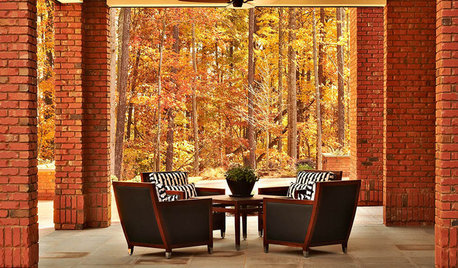Sorry to make use of a somewhat catchy title, but I thought it might be more interesting than "planting bulbs - the easy way".
Several decades ago - when Crockett was still hosting "The Victory Garden" - my daughter, Heather, and I spent much of a day "planting" a semi-circular bulb garden around a lamp post in the front yard. The diameter of the garden was 14 feet and its radius was 7 feet. A semi-circular "fan" shaped design around a lamp post that was topped over by an electrified old steam locomotive signal lamp.
We spent part of the late morning "preparing" the soil by digging down to a depth of about 8 or so inches; then adding several 40 pound bags of peat moss and cow manure and then attempted to mix all of this meager stuff into the clayish soil we had just dug out.
We then went to "work" with two of those typical bulb planters that are - sometimes - of little or no use and planted the bulbs - leaving enough space for other plant material - of course.
Because of the poor structure of this "soil", we often had to use both hands, some good muscle power, and a great deal of body weight/strength to work the planter into the ground in order to plant the bulbs.
When we completed our very tiring work, we went inside, made supper, relaxed and ate our dinner while watching Crockett's Victory Garden.
Wouldn't you know it; his program was on the planting of bulbs and he, of course, described and showed how "easy" it was to plant bulbs with this use of the bulb planter.
Heather and I just looked at each other in some digust - at least, Crockett's soil had been deeply and well prepared so that his bulb planter cut through the soil with the ease of a warm knife cutting through room temperature butter.
Since bulbs are somewhat like pregnant women on their way to the hospital, our bulbs came up tried and true and bloomed very well in the spring. In their second year, the bulbs were less in number and didn't bloom as profusely. By the third year, many of them had simply petered out or had disappeared - mostly.
Tulips have a bad habit of dividing more profusely than daffodils and because of the structure of the soil, many of them had simply divided down into a diameter much less than the size of the tip of my smaller fingers. Daffodils faired a tad bit better, but they didn't increase in number. And because of the clayish structure of the soil, a goodly number had simply died, because the strucure wasn't loose enough and/or deep enough to allow for good root growth and the obtainment of good nourishment for future bloom. In effect, our bulbs were planted with a clay soil "straight jacket" around them.
By the third summer, I had read more "gardening books" including the wonderful "Handbook on Soils" by the Brooklyn Botanic Garden, which showed the difference of root growth between a deeply and well prepared soil and a soil that was largely compacted in its structure. I had also read John Madson's "Where the Sky Began: Land of the Tallgrass Prairie" which is an absolute must read for any tallgrass prairie gardener - especially, its chapter on prairie soil structure and "The Great Weathers" and had also by that time read the wonderful chapter entitled "Failure" in the superb and also must read "Green Thoughts: A Writer in the Garden" by Eleanor Perenyi.
So in the late summer of the third year, I outlined two garden areas - the former semi-circular one noted above and another garden area - 16 feet in diameter and went to work once again and kept on digging and digging and digging until I hit the good deep prairie loam that I knew lay beneath the clay soil - the "remains" of the basement of the house.
A few people driving by our slow street stopped and inquired as to whether I had a "water" problem of some sort. When I informed them that I was deeply and well preparing the soil structure of two garden areas, I believe that they were either dumbfounded by my efforts and/or thought me to be slightly nutty.
Oh well, at least my gardening efforts "entertained" some folks in their travels.
Once I reached the good prairie loam beneath the clayish soil - about 22 to 24 inches down - I, obviously, had a new "problem" to confront.
How to create a loose and well prepared soil structure without too much effort. Within a very short period of time, I thought of the idea of renting a cement mixer and did.
Before I employed it, I obtained 14 six cubic foot bales of sphagnum peat moss, two small truck loads - the truck being borrowed from a friend - of aged cow manure, which came from a farmer friend of his and one truck load of coarse sand from a gravel pit several miles away.
I then took a small rubbermaid wash tub and a less than 1 pound coffee can and began to create a soil structure. A can or two of the original soil, a can or two or three of the sphagnum peat moss, a can or two of the aged cow manure and mixed the ingredients all together until I got the soil mixture that I wanted.
I then "translated" the coffee can proportions into shovefuls, turned on the rented cement mixer and went to work. After the cement mixer had more than sufficiently done its job, I off loaded the mix into a wheelbarrow, dumped the contents into the large holes and went back to work mixing up another batch of soil.
When I finished with the last of the mixture, Heather and I went back to work the next day and literally "played" in the soil to plant our bulbs, old fashioned roses, peonies, etc. It was 'child's play' and we performed our work far easier than had James Crockett in planting bulbs.
Since the soil structure was now deeply and well prepared, all that was or is really needed is the application - every year or so - of some good organic mulch - ala Ruth Stout - and, perhaps, some fertilizer now and the. In my personal case, I made use of the organic mulch - provided cheaply or without cost - by our local light & power company - the ground up leaves, branches and stems of the trees they pruned during the summer months.
Well, now that I have reached the young age of 64, I am not entirely certain that I want to involve myself in another extensive soil structure project. But since I moved from central Illinois to northwestern Michigan, I had to come up with some kind of solution other than - perhaps - the rental of a garden tiller to slightly improve the soil structure where we garden. Our soil is a mixture of fairly decent garden loam mixed in with some clay and sand. Not too bad for most planting material.
However, I didn't want to spend a great deal of time with either a good shovel, spade, digging fork or a trowel. Again, some research on the gardenweb forums and on the Internet and a little imagination came to my rescue.
A few days ago, my new "Pro Gardening Auger System" arrived and I finally got to enjoy its use this afternoon when I finally began to plant my small array of various bulbs and other fall plantings.
This system is made of high grade industrial steel, has a sharpened blade, and consists of a 3 inch diameter auger and a 4 inch diameter auger with a 24 inch extension post that is easily linked to either one of the augers.
For my first efforts, I choose to make use of the 3 inch diameter auger without the extension post and went to work and easily - and I do mean easily - made 8 three inch holes to about 8+ inches in depth - in a very, very short period of time.
From then onward, I simply removed a bit of the remaining loosened soil at the bottom of the hole with a narrow trowel, placed a little bit of the soil mixture I had made into the ground, put in about a tablespoon plus of an organic fertilzer mix into the hole that the auger had created, mixed it in, put a tid bit more of soil into the hole, planted the bulb - in this case a white Hyacinth - and covered it up with soil - and went on to the next hole - until the light became a bit too dark to continue my effortless work.
At any rate, the "gardening moral" of this story is simply to encourage those reading this post to consider the use of a well made and well designed soil auger to make 'work' in the garden all the more easier and enjoyable.
As for me, I am looking forward to not only finish the planting of the rest of my bulbs with far greater ease, but to also use this well made and designed auger to plant a small tree sapling of "Amelanchier Arborea", some ornamental grasses, i.e. "Inland" or "Northern Sea Oaks - Chasmanthium latifolium and "Flame Grass" - Miscanthus 'Purpurascens' a peony - "Moon over Barrington", a Griffith Buck rose - "Hawkeye Belle" and one or two Geranium sanguineum 'Max Frei' with equal ease. Of course, with the later and bigger plants, I'll have to dig/drill several holes in a small area and then simply remove the soil in between the holes, remove the churned up soil with greater ease, etc, before I plant the tree, peony, rose, etc. A planting project made much easier by a good soil auger.
There are several different soil augers on the market which can also provide good to fair results. I have also purchased a 1 3/4 diameter inch auger from Ace Hardware, but found it a bit too small for some of my purposes. Nevertheless, I think it will be useful for some of the smaller bulbs - crocus, dutch iris and the like - and other projects such as drilling holes for placing fertilzing tree spikes a little deeper into the ground.
So for those of you who are approaching the "younger" years of whatever age or who are on the verge of old age, whatever that might be or who are looking for innovative ways to make gardening easier on their aching backs, legs, knees or whatever, I highly recommend the use of a good system soil auger.
Although I don't usually "plug" products, I think that the "Pro Gardening Auger System" is well worth the price of purchase. Quite frankly, it is the best designed auger and far better made that I've come across to date. I've provided a link below for those so interested.
As always, I am hoping that this little bulb planting story and its various employed solutions will bring greater joy and ease to your gardening efforts and also, perhaps, some amusement.
Best wishes in your good efforts of nurturing life.
Bill
Here is a link that might be useful: Pro Gardening Auger System
















ego45
shrubs_n_bulbs
diannp
Mozart2Original Author
diannp
Mozart2Original Author
madspinner
Mozart2Original Author